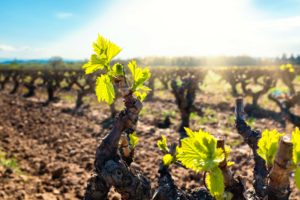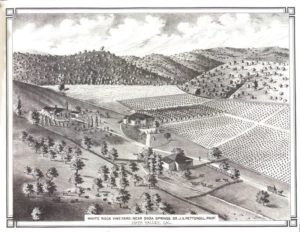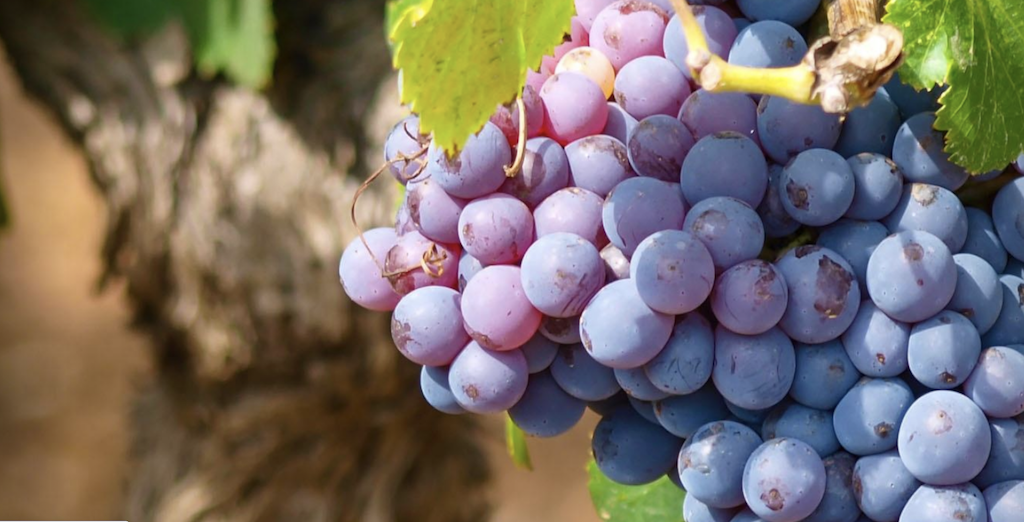The history of Zinfandel is shrouded in mystery. While its origin had to be European as it is the same grape species –vitis vinifera- as other fine European wine varieties: Cabernet Sauvignon, Chardonnay, Pinot Noir or Syrah, no relationship could be found to any known European varietal.
Over the course of the last 170 years, Zinfandel has established a quality reputation in California becoming known as “America’s Heritage wine”. The history of Zinfandel is a classic All-American success story—being transformed from a little-known grape into one that has achieved such tremendous popularity that it is grown on more than 39,000 acres. Zinfandel is now the third most crushed wine grape in California, after Cabernet Sauvignon and Chardonnay.

While the true origins of Zinfandel remained a mystery into the early 21st century, historians have traced Zinfandel’s roots in the United States back to the 1820s, when George Gibbs, a Long Island, New York nursery owner, imported unnamed cuttings from the Schonbrunn imperial horticultural collection in Vienna, Austria. By 1832, a Boston nursery was advertising “Zinfendal” vines for sale. Between 1835 and 1845 “Zinfandel” became a popular “table grape” grown in hothouses in the Northeastern United States. Frederick Macondray a sea captain and horticulturist, who grew the “Zinfindal” in Boston, Massachusetts, is credited with bringing some of the first Zinfandel cuttings to California on his sailing ship in the early 1850s.*
It is conjectured that after the 1849 Gold Rush, timber and wire were scarce. Production of Zinfandel grapes surged, in part, because it could easily be cultivated using the traditional European “head pruning”, a technique still used today requiring no special equipment or scarce resources. Zinfandel’s appeal soared during this time because it grew vigorously and provided miners with a versatile, substantial beverage.
 In an excerpt from his memoir, Joel Peterson, Founder of Ravenswood Winery & Once and Future writes about Zinfandel*:
In an excerpt from his memoir, Joel Peterson, Founder of Ravenswood Winery & Once and Future writes about Zinfandel*:
“Made into prizewinning wine (under the name Black St. Peter’s) by San Jose nurseryman Antoine Delmas, it was introduced to Napa and Sonoma by vineyardists, Joseph Osborne and William Boggs; the first wine grape grown there besides the Mission and Muscat, it was found good for a whole range of products from sparkling to pink to claret and port. Well-suited to Northern California – in Boggs’ trial plot of several imported varieties, it was the only one to survive – it was roundly declared the best choice for dry red table wine and was by far the most popular variety in the great grape-planting boom of the 1880s. When the consequently-overplanted industry went bust the following decade, Zin bore the brunt of the blame, though most of the vilified wine came from the sweltering Central Valley. In the North Coast, good Zinfandel vineyards hung on-indeed, kept being planted by Italian immigrants who were savvy about where to locate them. These vines continued providing fruit to home winemakers during Prohibition, to bulk-wine purveyors after World War Two, and, in the 1960s, to a new wave of artisans and connoisseurs (present family company included), rekindling the intrigue attached to our “heritage” grape.
A semi-breakthrough on identifying the ancestral home of Zinfandel came in 1967, when Austin Goheen, a U.S. Department of Agriculture plant pathologist and U.C. Davis professor, came across the Primitivo grape in Puglia, a region of southeastern Italy. Noting a similarity between its wine and vine and those of the California grape, he had cuttings sent to Davis, where it was planted alongside Zinfandel. At maturity the morphology of the two were indistinguishable, and in 1975 a PhD student named Wade Wolfe subjected both to isozyme fingerprinting, in which an electric current is applied to isolated plant enzymes that respond consistently for each grape variety. The Primitivo and Zinfandel patterns matched, but until DNA profiling came into its own a couple of decades later, all that this indicated was that the two were closely related, not necessarily identical. Moreover, Italians considered Primitivo an imported variety, so the true origin remained unknown.
Directly across the Adriatic Sea, a popular Dalmatian grape named Plavac Mali also bore a resemblance to Zinfandel. Now part of Croatia (formerly of Yugoslavia), in the nineteenth century Dalmatia belonged to the Kingdom of Hungary, whose grapevines were collected in the Schoenbrunn archive that sent Zinfandel from Vienna to Long Island. California Winemaker Mike Grgich, a Croatian immigrant whose Chateau Montelena Chardonnay won the white-wine division of the Judgment of Paris tasting in 1976 (and who went on to found his own eponymous winery, which produced Zinfandel, among other wines) thought Plavac Mali was the same as Zin. U.C. Davis found otherwise, but the similarity and geographical proximity prompted lingering questions as to whether the vine at Davis had been correctly identified.
In 2000, researchers at UC Davis confirmed what everyone suspected: that Zinfandel and Primitivo were the same grape, and Plavac Mali wasn’t (at least not the vine called Plavac Mali that was growing at Davis). Additional research was undertaken between UC Davis and the University of Zagreb. They discovered that the non-Zinfandel component in Plavac Mali’s DNA was a match for Dobricic, revealing that it and Zinfandel were Plavac Mali’s parents. This made it logically inferable that Zin-by whatever name-should be found in the same area of Croatia.”
_______________________________________________________________________________________________________________________________________________________
In 2001, researchers discovered nine vines of locally-known “Crljenak Kaštelanski” on Croatia’s Dalmatian coast. DNA fingerprinting confirmed that this grape had the same DNA structure as California Zinfandel. Mystery solved! Further investigation discovered that this grape’s original name is “Tribidrag” in Croatia and is a very ancient grape.
_______________________________________________________________________________________________________________________________________________________

Joel Peterson’s book continues with insights that trace Tribidrag:
Proceeding to Google Tribidrag, viticulturist Edi Maletic from the University of Zagreb came across an obscure paper about the ancient Adriatic wine trade. It was written by a historian named Ambroz Tudor, who was duly commissioned to research the name. Between 1200 and 1600 A.D., the Dalmatian coast was controlled by Venice, which erected a series of fortresses* [*Or castles, as in the names “Kastela” and “Crljenak Kastelanski” – “black grape of the castle”] there as a bulwark against invasion by the Saracens to the East. Scouring old Venetian trade and agricultural documents, Tudor found several Tribidrag references stretching back through time: an 1823 catalog of cultivars compiled in Trogir, west of Kastela; a 1546 mention of a Tribidrag vineyard on the island of Korucla; a 1529 reference to a Tribidrag sale on the island of Vis; a 1518 division of a Tribidrag vineyard property on the island of Hvar; and a 1488 record of a barrel of Tribidrag exported from Split to Puglia in 1488. Perhaps the most titillating discovery was a 1623 association with the infamous privateer Murat Reis the Younger (a.k.a. Jan Janszoon), a Dutchman turned Barbary pirate.
Although the latter connection might seem to confirm Zinfandel’s outlaw image, Tudor found that Tribidrag was largely associated with the nobility. If you were drinking a red wine at a masked ball in Venice between 1200 and 1600 A.D., the likelihood is that it was Tribidrag – a well-known, widely appreciated cultivar along the eastern Adriatic coast from Istria to Montenegro, documented in the way that “noble” French grapes like Cabernet Sauvignon would be in centuries to follow.
That term-“centuries to follow”-revealed another significant fact. The earliest records of Cabernet Sauvignon date only to around 1700, roughly concurrent with the birth of Plavac Mali, one of Zinfandel’s many (two dozen at last count) offspring. For Tribidrag to be sufficiently well established in Croatia to migrate to Italy before Columbus even sailed to America, it had to be a very old variety. Indeed, Swiss ampelographer José Vouillamoz, in extending the same DNA methodology that enabled (UC Davis Professor Carole) Meredith to determine the genealogy of Cabernet, Chardonnay, Pinot, and Syrah, now includes Tribidrag /Zinfandel on a rarefied list of 13 “founder” grapes* [*Cabernet Franc, Cayatena Blanca, Garganega, Gouais Blanc, Luglienga, Mondeuse Noire, Muscat Blanc a Petits Grains, Pinot Noir, Nebbiolo, Reze, Savagnin, Teroldego, and Tribidrag.]—those core vitis vinifera varieties from which all the other wine grapes we know today are descended. While this doesn’t necessarily confer “noble” status quality-wise (a few of the founders are clunkers), it further embellishes Zinfandel’s venerable history. Turns out that this “orphan grape,” which, after making its way across the Atlantic, did so much for the wine industry in California (and for me!) can, when traced to its roots, almost be called aristocratic. If it isn’t exactly the story of “The Prince and the Pauper,” it isn’t too far off.

Zinfandel’s expansion in California in the 20th century is a testament to its hardy constitution, as well as its noble lineage. While most of California’s vineyards were destroyed by phylloxera in the late 1800’s, Zinfandel vines were among the first vines replanted on rootstock starting around 1885. By mid-century it had become the most important varietal among California red table wines-an 1888 census shows that over one-third of all grapevines were Zinfandel. As vineyards were replanted, Italian immigrant families took a lead in growing and making Zinfandel. They also adopted the technique of “field blends” which meant they planted a sprinkling of additional varietals—Petite Sirah, Alicante Bouchet, Carignane—co-mingling them with Zinfandel in the vineyard. These grapes are harvested along with the Zinfandel clusters, crushed and blended from vineyard to bottle, adding additional complexity to the wine. Having survived Prohibition in the 1920s, largely thanks to an exclusion for home winemaking, by mid-century Zinfandel had become the most important varietal among California bulk-wine producers.
The wave of blush wines in the 1970’s started when California wineries began to draw free-run juice from Zinfandel grapes, fermenting it as “white” Zinfandel. At that time, red table wines had decreased in popularity, and the growers would have been forced to graft over to other varietals, eradicating the old vines forever. The White Zinfandel trend actually led to the preservation of old Zinfandel vines.
The 1990’s brought a focus on research and the involvement of Zinfandel enthusiasts in a movement to celebrate and promote the varietal and the red wines produced from it. The first ZAP tasting gathered 22 wineries together at The Mandarin Hotel in San Francisco in 1992. By the end of the decade, Zinfandel had become competitive in the world market, proving to an international audience that America could produce fine red table wines from Zinfandel comparable to their European counterparts.
Researchers continue their quest to understand the unique success of Zinfandel’s California clones compared to their counterparts around the world. Advocates and producers continue to expand their efforts, creating a movement dedicated to advancing the appreciation of Zinfandel wine and preserving its rich history.
To learn more about where Zinfandel is grown in California, visit:
Growing Regions – ZAP (zinfandel.org)
To discover Zinfandel’s some of the old vines still planted throughout California, visit:
Experiencing California’s Legendary Zinfandel Vineyards – ZAP
Visit California’s Zinfandel wineries! Explore here: www.zinfandeltrail.com
Updated August 2023
*Special thanks to Joel Peterson, founder of Ravenswood Winery and Once & Future for his assistance and permission to use his book.
